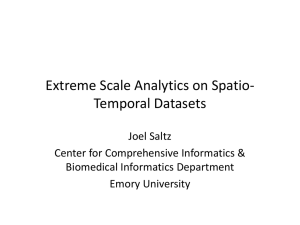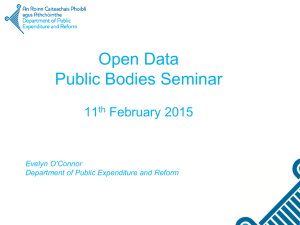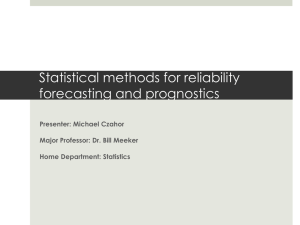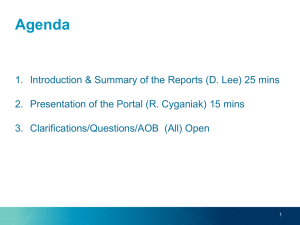WCRP/GCOS/WOAP Intercomparison Workshop
advertisement
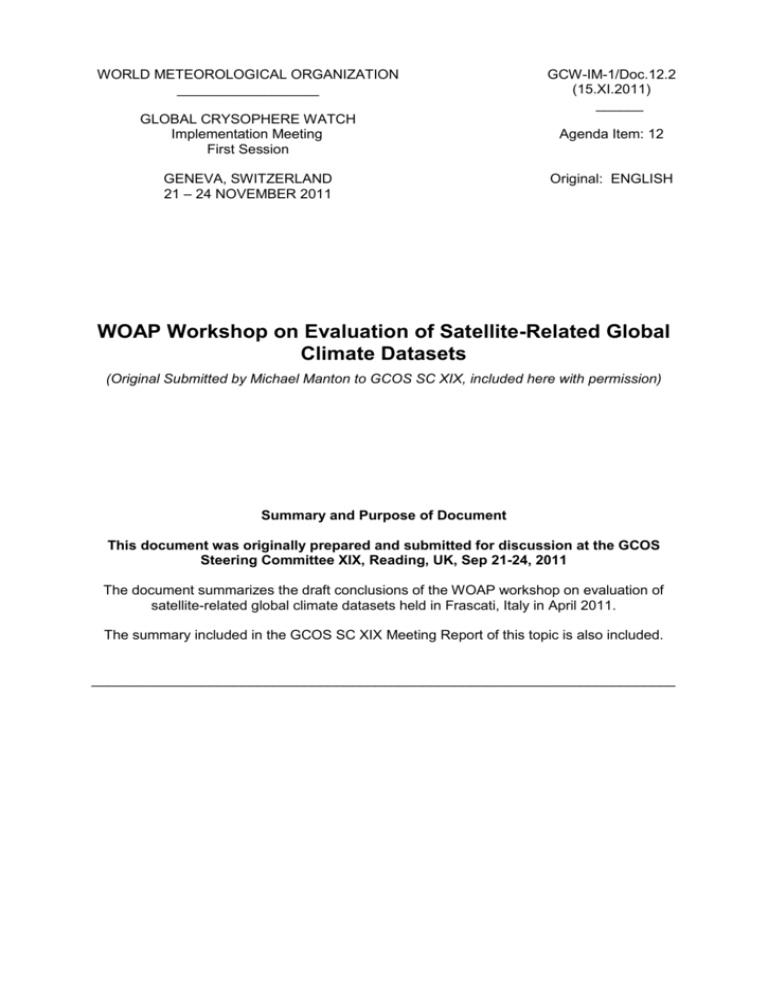
WORLD METEOROLOGICAL ORGANIZATION
__________________
GLOBAL CRYSOPHERE WATCH
Implementation Meeting
First Session
GENEVA, SWITZERLAND
21 – 24 NOVEMBER 2011
GCW-IM-1/Doc.12.2
(15.XI.2011)
______
Agenda Item: 12
Original: ENGLISH
WOAP Workshop on Evaluation of Satellite-Related Global
Climate Datasets
(Original Submitted by Michael Manton to GCOS SC XIX, included here with permission)
Summary and Purpose of Document
This document was originally prepared and submitted for discussion at the GCOS
Steering Committee XIX, Reading, UK, Sep 21-24, 2011
The document summarizes the draft conclusions of the WOAP workshop on evaluation of
satellite-related global climate datasets held in Frascati, Italy in April 2011.
The summary included in the GCOS SC XIX Meeting Report of this topic is also included.
__________________________________________________________________________
GCW-IM-1/Doc.12.2, p. 2
Background
Under the auspices of the WCRP Observations and Assimilation Panel (WOAP), a workshop
was hosted by the European Space Agency (ESA) in Frascati, Italy on 18-20 April 2011 to
prepare a technical report on the evaluation of global climate datasets; eight satellite-related
essential climate variables (ECVs) were considered. The datasets covered the atmospheric,
ocean and terrestrial domains of GCOS and they were at different stages of maturity.
As a basis for detailed consideration of global climate datasets, the utility of these datasets
was first summarised and it was concluded that global climate datasets are vital components
of climate science, supporting activities such as
monitoring of climate variability and change on a range of time scales
monitoring of forcing of the climate system
prediction of climate variability and change
attribution of causes of climate change
characterisation of extreme climate events.
Global climate datasets relating to the eight selected ECVs were evaluated against the
GCOS Guidelines of Dataset Generation, which promote a rigorous process for the
development and evaluation of global datasets. That process should ensure that the quality,
utility and accessibility of datasets is adequate for the identified applications. It is recognised
that different datasets may be fit for different purposes.
Status of ECV global climate datasets
The eight ECVs selected for evaluation were
Atmospheric domain
Cloud properties
Surface radiation
Ocean domain
Sea ice
Sea-surface temperature (SST)
Surface winds
Terrestrial domain
Soil moisture
Fraction of Absorbed Photosynthetically Active Radiation (FAPAR)
Snow cover.
For cloud properties, the EUMETSAT Cloud Retrieval Evaluation Workshop (CREW) and the
GEWEX Cloud Assessment were considered. These assessments are interesting to
compare as the CREW activity was focused mainly on Level 2 data, while the GEWEX
activity assessed various physical properties of long-term global cloud (Level 3) datasets.
For surface radiation, the GEWEX Radiative Flux Assessment was discussed. Key
messages from all these assessments are that formal evaluation is a major task and that
dedicated resources need to be allocated to that task.
For SST, datasets developed through the Group for High Resolution SST (GHRSST) were
evaluated. Questions remain about how best to exploit the mix of in situ platforms available
for quality control and evaluation of GHRSST SST products. For surface winds, there was a
focus on scatterometer estimates of the surface wind field. It was found that a concerted
effort is needed to support appropriate calibration, evaluation and reprocessing activities on
surface winds. For sea ice, several different datasets have been assembled, and there
have been some inter-comparisons. However, the nature and sources of the
differences have not been fully documented.
GCW-IM-1/Doc.12.2, p. 3
For soil moisture, Level 2 datasets based on active and passive satellite instruments were
evaluated. It is seen that reprocessing of a number of fundamental climate data records
(FCDRs) and comparison of existing climate datasets and their associated algorithms would
help ensure the consistency and quality of global climate datasets. For FAPAR, the earlier
assessment carried out by GTOS was seen to provide adequate documentation for that
ECV, but resources are needed to support work on reference sites for in situ evaluation. It
was noted that land cover classification is an important aspect of modelling used to derive
FAPAR, and a consistent approach to the detection of land cover change would help ensure
consistency across a range of terrestrial ECVs. For snow cover, satellite-based estimates
of snow covered area, snow water equivalent, snow depth and snow wetness are
routinely prepared. The impacts of vegetation cover, wet snow and complex terrain
can limit the accuracy of global climate datasets of snow cover.
General issues
To provide a consistent framework for the workshop evaluations, the status of each dataset
was entered in an inventory that itemises the evaluation elements of the GCOS Guidelines.
The establishment and maintenance of such an inventory at a site, such as the NOAA Global
Observing Systems Information Centre (GOSIC), will provide a consistent and accessible
source of information on global climate datasets. The admission of new datasets into the
inventory is expected to be managed by the GCOS Panels.
The inventory of global ECV datasets will be a resource for users of climate observations to
identify and locate data for their particular applications. It will also be of value to producers of
datasets in providing a consist evaluation of strengths and weaknesses, and hence a means
for determining priorities for further development. Inspection of inventory components can
also highlight the vulnerability of specific ECVs to potential gaps in satellite instruments; for
example, the risk to continuity of microwave radiometers with low-frequency channels may
impact on the global SST record.
From consideration of the evaluation of the ECV datasets, it is concluded that special
attention needs to be given to some issues; in particular
observing strategies for ECVs
reprocessing of FCDRs
atmospheric adjustment for satellite retrievals
independent expert-group assessment of datasets
indices of maturity and uncertainty
interdependence of variables
long-term homogeneity of datasets.
Conclusions on each of these issues are summarised below.
The global observing system for climate is an integrated system with two major components:
complementary data are provided by the satellite constellation and the global in situ networks
in the atmosphere and ocean and on land and ice. While satellites can generally provide
global coverage, they cannot measure all the variables of interest and they often are not
designed to provide data with long-term stability and homogeneity. The in situ networks can
be used for calibration and evaluation of satellite data, and they are vital for the
measurement of variables, such as surface air temperature and sub-surface ocean
properties, that cannot be measured from satellites.
These global systems are
supplemented by reference sites ('super-sites'), which provide detailed point measurements
of several variables in specific climatic zones. Observations from these sites can provide
anchor points for global climate datasets, as well as yielding information on the processes
controlling the budgets of water, energy and chemical species. All three components of the
GCW-IM-1/Doc.12.2, p. 4
global observing system are needed to ensure the quality and comprehensiveness of global
climate datasets.
Space agencies are encouraged to give sustained attention to activities that ensure the
accuracy and consistency of observational datasets from satellites used to derive ECV
products. As calibration methods improve there will be a periodic need to reprocess FCDRs
and the ECV products that depend on them. It is vital for these activities to be continued and
expanded to meet the full range of user requirements. The international activities of GSICS
and SCOPE-CM and the climate reprocessing activities of ESA and NASA are important
initiatives supporting these needs.
Many surface variables require the removal of atmospheric effects on radiances measured
by satellite instruments, and so atmospheric adjustment is a common procedure for climate
datasets. These adjustments use a range of ancillary data in somewhat different ways for
different ECV datasets. While the adjustments are statistically based, there is little scope to
develop an agreed consistent approach. However, research aimed at the development of an
agreed forward model for the calculation of retrievals should lead to greater consistency
among ECV datasets.
All producers of climate datasets carry out self-assessment of the utility and uncertainties of
the products. However, independent expert-group assessments of the datasets associated
with ECVs markedly enhance the utility and encourage improvements of individual datasets.
This process is time-consuming and needs to be properly resourced in the future, in order to
confirm the commitment of agencies to transparency and quality in the generation of global
climate datasets. International independent assessments are seen as an important
mechanism to enhance and promote the utility and application of these datasets. For
example, it would be timely to commence a coordinated international assessment process for
global Level 2 soil moisture datasets, with a view to expanding the scope and depth as
scientific progress is made.
In order to promote an effective dialogue between users and producers of global climate
datasets, an agreed lexicon based on the maturity index will be used in the ECV inventory to
articulate the relative strengths and weaknesses datasets for specific applications. More
work is required to develop agreed metrics of uncertainty in global datasets that transparently
account for the many sources of error in generating a global climate dataset from satellitebased measurements.
Many ECVs represent a number of physical variables and so it is appropriate to account for
their interdependence when generating datasets for each variable. Moreover a group of
variables is often constrained by physical processes, such as the conservation of energy or
water. Such constraints should be used in the generation of the individual datasets, and they
can also be used in the evaluation of datasets. To maximise the benefits of accounting for
the interdependence of variables, it is often desirable for agencies to coordinate the
reprocessing of their datasets.
The specific variables associated with an ECV can evolve with advances in scientific
knowledge and instrumentation, and such changes need to be accounted for to assure the
long-term record of ECVs. For example, the products being generated by the Group for High
Resolution SST (GHRSST) have enhanced the quality and reproducibility of global SST
datasets, but work is required to ensure that the climate record can be extended consistently
back in time as well as forward; that is, the long-term homogeneity of global climate datasets
must be maintained.
The workshop brought together experts from across the geographical domains and found
that, while there are specific issues associated with ECVs for each domain, there are many
commonalities in the development and evaluation of global climate datasets across domains.
GCW-IM-1/Doc.12.2, p. 5
Further international cooperation will lead to enhancements in the quality, utility and
accessibility of global climate datasets.
Text in Draft for inclusion in GCOS SC XIX Report: Workshop on Evaluation of
Satellite-Related Global Climate Datasets
A summary of the WOAP workshop on the Evaluation of Satellite-Related Global Climate
Datasets was given by Dr. Michael Manton. Dr. Manton was both the principal organizer of
the workshop, which was hosted by the European Space Agency (ESA) in Frascati, Italy
from 18-20 April 2011, and the lead author of the report of the workshop.
The objectives of the workshop were to evaluate some ECV datasets against the GCOS
Guidelines, to provide a framework for the future evaluation of global climate datasets, and to
assess the value of establishing an inventory of the status of ECV datasets. As a basis for
detailed consideration of global climate datasets, the utility of these datasets was first
summarised, and it was concluded that global climate datasets are vital components of
climate science, supporting activities such as monitoring of climate variability and change on
a range of time scales, monitoring of forcing of the climate system, prediction of climate
variability and change, attribution of causes of climate change, and characterisation of
extreme climate events. Some general issues addressed by workshop participants included
observing strategies for ECVs, reprocessing of Fundamental Climate Data Records
(FCDRs), atmospheric adjustment for satellite retrievals, independent expert-group
assessment of datasets (considered very important), indices of maturity and uncertainty,
interdependence of variables, the need for long-term homogeneity of datasets, and
international cooperation.
To provide a consistent framework for the workshop evaluations, the status of each dataset
considered at the workshop was entered in an inventory that includes a description of the
extent to which the GCOS Guidelines have been followed. The establishment and
maintenance of such an inventory at a site, such as the NOAA Global Observing Systems
Information Centre (GOSIC), would provide a consistent and accessible source of
information on global climate datasets. The admission of new datasets into the inventory is
expected to be managed by the GCOS Panels.
The Steering Committee thanked Dr Manton for his work on the meeting and in drafting the
report, and was grateful to ESA for its hosting of the meeting. The Committee considered
dataset evaluation to be an important activity on which GCOS should continue to collaborate
with WCRP and other partners. It agreed that GOSIC would be a good place to host the
inventory, although some concerns were voiced as to whether GOSIC could be used for this
purpose.
